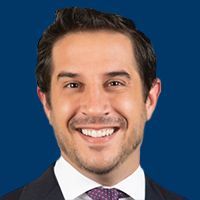FDA Grants Niraparib Priority Review in Ovarian Cancer
The FDA has granted a priority review to a new drug application for the PARP 1/2 inhibitor niraparib for use as a maintenance therapy in patients with recurrent epithelial ovarian, fallopian tube, or primary peritoneal cancer who have responded to platinum-based chemotherapy.
Mary Lynne Hedley, PhD
The FDA has granted a priority review to a new drug application (NDA) for niraparib for use as a maintenance therapy in patients with recurrent epithelial ovarian, fallopian tube, or primary peritoneal cancer who have responded to platinum-based chemotherapy, according to Tesaro, the manufacturer of the PARP 1/2 inhibitor.
The NDA is based on data from the phase III ENGOT-OV16/NOVA trial, in which maintenance niraparib reduced the risk of progression or death by 73% compared with placebo for patients with germline BRCA-positive platinum-sensitive, recurrent ovarian cancer.1,2 After a median follow-up of 16.9 months, the median progression-free survival (PFS) with maintenance niraparib was 21.0 months compared with 5.5 months for placebo in patients with germline BRCA mutations (HR, 0.27; 95% CI, 0.17-0.41; P <.0001).
These findings remained consistent across subgroups of patients, including those without BRCA mutations. Under the Prescription Drug User Fee Act, the FDA is scheduled to make its final approval decision on or before June 30, 2017.
“FDA's acceptance of the niraparib NDA with a priority review designation is an important milestone for Tesaro, and represents a significant step in our efforts to bring meaningful therapies to women with ovarian cancer,” Mary Lynne Hedley, PhD, president and COO of Tesaro, said in a statement. “We believe niraparib could become an important new treatment option for patients with recurrent ovarian cancer, and we look forward to working with the FDA during the review process.”
The phase III study randomized patients in a 2:1 ratio across 2 independent cohorts. In the first cohort, 201 patients with germline BRCA mutations received niraparib at 300 mg daily (n = 138) or placebo (n = 65). In the second cohort, 345 patients with non-germline BRCA-mutant tumors received the PARP Inhibitor (n = 231) or placebo (n = 114). Patients in this group were tested for homologous recombination deficiency (HRD), and could be either positive (n = 162) or negative (n = 134). Of those who tested positive, 47 had somatic BRCA mutations and 115 were wild-type.
Patient demographics were well balanced between the arms for each cohort. In the germline BRCA group, the median age was 57 years and 65.9% had an ECOG performance status (PS) of 0. In the placebo group, the median age was 58 years and 73.8% of patients had an ECOG PS of 0. Overall, 48.6% and 53.8% of patients had received ≥3 prior therapies, in the niraparib and placebo arms, respectively.
Across both cohorts, the majority of patients had stage III cancer (68.8% to 74.1%). Approximately half of patients had achieved a complete response to prior platinum-based therapy and a quarter had received prior bevacizumab (Avastin). In the non-BRCA-mutant arm, 33.8% and 32.8% of patients had received ≥3 prior therapies.
In the germline BRCA mutation group, the chemotherapy-free interval was 22.8 months with niraparib compared with 9.4 months for placebo (HR, 0.26; 95% CI, 0.17-0.41; P <.001). The median time to subsequent therapy was 21 months with niraparib versus 8.4 months with placebo (HR, 0.31; 95% CI, 0.21-0.48).
Findings for overall survival were not yet mature (fewer than 20% of events). At the time of the analysis, niraparib had reduced the risk of death by 27% versus placebo, although this finding was not statistically significant (HR, 0.73; 95% CI, 0.480-1.125; P = .1545).
In patients with HRD-positive, BRCA wild-type tumors, median PFS was 9.3 versus 3.7 months for niraparib and placebo, respectively (HR, 0.38; 95% CI, 0.23-0.63; P <.001). In those with HRD-positive, somatic BRCA-mutated tumors, the median PFS was 20.9 months with niraparib versus 11.0 months for placebo (HR, 0.27; 95% CI, 0.08-0.90; P = .02). In patients with HRD-negative, non-germline BRCA-mutated tumors, median PFS was 6.9 versus 3.8 months for niraparib and placebo, respectively (HR, 0.58; 95% CI, 0.36-0.92; P = .02).
In those with non-germline BRCA mutations regardless of HRD status, the median chemotherapy-free interval was 12.7 versus 8.6 months for niraparib and placebo, respectively (HR, 0.50; 95% CI, 0.37-0.67; P <.001). The median time to subsequent therapy was 11.8 versus 7.2 months (HR, 0.55; 95% CI, 0.41-0.72; P <.001) and the median PFS2 was 18.6 and 15.6 months for the niraparib and placebo arms, respectively (HR, 0.69; 95% CI, 0.49-0.96; P = .03).
Across cohorts, 14.7% of 367 niraparib-treated patients discontinued therapy due to an adverse event (AE) compared with 2.2% of the 179 patients in the placebo arm. There were no treatment-related deaths in the study. In the follow-up period, 1 patient in the niraparib arm and 2 in the placebo group died of myelodysplastic syndrome or acute myeloid leukemia. One of these deaths in each arm was deemed to be treatment related.
The most common all-grade AEs for niraparib versus placebo, respectively, were nausea (73.6% vs 35.2%, respectively), thrombocytopenia (61.3% vs 5.6%), fatigue (59.4% vs 41.3%), anemia (50.1% vs 6.7%), constipation (39.8% vs 20.1%), vomiting (34.3% vs 16.2%), and neutropenia (30.2% vs 6.1%).
The most common grade 3/4 AEs in the niraparib arm were hematologic, and included thrombocytopenia (33.8%), anemia (25.3%), and neutropenia (19.6%). The most common non-hematologic AEs were hypertension (8.2%), fatigue (8.2%), and nausea (3%). A majority of hematologic AEs were experienced in the first 3 cycles.
An expanded access program for niraparib in the United States is scheduled to open in January 2017, according to Tesaro.
References
- Mirza MR, Monk BJ, Oza A, et al. A randomized, double-blind phase 3 trial of maintenance therapy with niraparib vs placebo in patients with platinum-sensitive recurrent ovarian cancer (ENGOT-OV16/NOVA trial). Presented at: 2016 ESMO Congress; October 7-11, 2016; Copenhagen, Denmark. Abstract LBA3_PR.
- Mirza MR, Monk B, Herrstedt J, et al. Niraparib maintenance therapy in platinum-sensitive recurrent ovarian cancer [published online October 8, 2016]. N Engl J Med. DOI: 10.1056/NEJMoa1611310.
The median time to progression or death during the first subsequent therapy following the study (PFS2) was 25.8 months for those who received maintenance niraparib versus 19.5 months for placebo (HR, 0.48; 95% CI, 0.28-0.82; P = .006).



